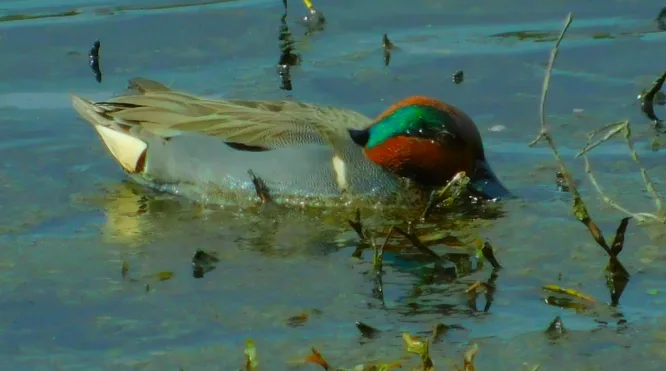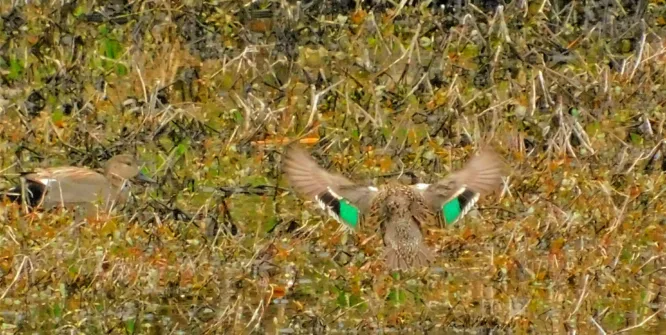Un-Teal We Meet: Little Dabblers in the Marsh
by Marcia Wilson

Dabbling Around
Pierce County’s three teal duck species have been seen at the CPTC marsh. Their small, crow-sized bodies are built like bush planes: hardy, resilient, and capable of traveling long distances. These are “dabbling ducks” that feed on the surface of the water instead of diving. If you see a duck that looks like it is blowing bubbles, chances are it is a dabbler.
The Green-wing is our most lively seasonal resident teal. CPTC’s marsh has a cool, shaded strip of forest and thickly planted shoreline, giving it a restful habitat between the grueling demands of migration and nesting. We once encountered a young couple sight-seeing on the edge of the wetlands who explained that the entire area had been one of Lakewood’s traditional duck-hunting grounds and they liked to visit it to remember their grandfather, one of those hunters. The Green-winged was surely one of the ducks served at the table, for they are the most hunted duck after the Mallard. This is because the rule, “tastes like chicken” doesn’t apply to the teal. They have a light, tender flavor without the usual strong “duck” experience on the tongue. The rule about “you are what you eat” doesn’t apply here, for teals love to eat snails, bugs, and other critters, except in winter when they incline to the watery plants. The persicaria that chokes the waterways of the PNW is happily eaten by this tiny duck. Since persicaria chokes up our waterways, Bon Appetit!

Teal are declining across the continent through loss of habitat. Luckily, a few years ago the college wetlands became more appealing to their needs, thanks to streambank restoration and controlled pumping from the City of Tacoma with an uptick in beaver dams.

Now that the marsh has fewer drying-out summers, we may see even more teal. Late winter to Early Summer is the best time to see one of the world’s smallest dabbing ducks, but look fast! They are high-velocity flyers clocking in at amazing 92kph. That’s 60mph. They can also run on land without easily tiring.
Color Trivia
Students studying graphic arts/advertising technologies can learn that the color teal is named after the ducks and not the other way around.
There are scores of psychologists that study the relationship we have between language and color. For example, can we see or recognize a color if we don’t have a specific word for it? If that is true, then society didn’t “see” teal until about 1917 when the word popped into print. All the teal ducks, which are the Green-winged, Blue-winged, and Cinnamon Teals, possess this color somewhere on their feathers. If the light hits at the right angle, their green feathers will turn blue, purple, or some indescribable shade in between.
